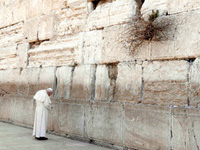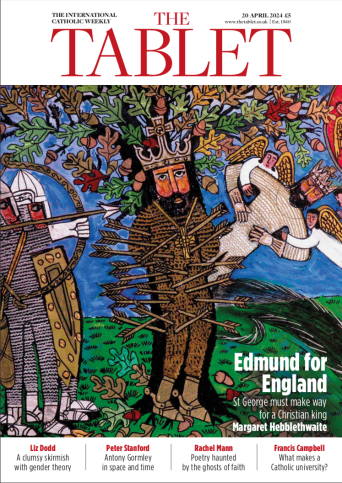Our generation has witnessed a religious revolution so extraordinary that it is sometimes hard to appreciate. We take interfaith dialogue for granted, assume that the Council of Christians and Jews has existed forever, and fail to blink when a rabbi and a priest hold a joint event. But go back a few decades and all three assumptions would have been laughable. This remarkable transformation is due in large part to Popes John XXIII and John Paul II – which is why they are not only Catholic saints, but Jewish heroes, too.
To appreciate the change that has occurred, we have to remind ourselves of the time that preceded them, although with some reluctance, as it was a dark period in terms of Jewish-Catholic relations. Jews were seen as perfidious and rebellious in both the gospels and the liturgy. They were labelled as Christ-killers. Of all the sins in the world, there could be nothing worse than the accusation of murdering the son of God. Whereas all other non-Christians may have lacked redemption, Jews were singled out for a malevolent role at the heart of the Christian narrative. Unfortunately, this negativity was not limited to the realm of theology, but spilled out into poisonous relations between ordinary Christians and Jews, especially when the Church reigned supreme in Western Europe. Thus the Middle Ages was a religious inferno of blood libels, book-burning, ghettos, Jew badges, crusader massacres, inquisitions, forced conversions and expulsions.
Centuries of hostility then culminated in the Holocaust, with six million Jews, every third Jew in the world, being killed. It may have been committed by the Nazis, but there is little doubt that it could not have occurred without the “Christian anti-Semitism” that created the mindset that made it possible.
How astonishing it was, therefore, when Pope John XXIII sought to turn away from such a past and establish a new relationship between the two faiths (along with many other reforms within the Church). In this respect, he ranks alongside Mikhail Gorbachev and F.W. de Klerk, who not only saw that their countries needed to change radically, but also had the courage to implement it.
It was he who instructed the adjective “perfidious” to be removed in the Good Friday prayer for Jews. He also led the way personally, meeting with Jewish leaders and greeting them with the words from Genesis that also echoed his own baptismal name: “I am Joseph your brother.” That simple sentence contained a world of change: no longer your rival or your enemy, but your brother.
Above all, he initiated the Second Vatican Council that led to the publication of Nostra Aetate and the ground-breaking declarations it made: that Jews as a whole were absolved of the guilt of deicide, that Judaism was not a relic of the past but had a continuing validity, that Jews today were equally beloved of God, that all forms of anti-Semitism are to be condemned. Co-existence replaced animosity. It was epitomised by a moving prayer about the Jews that John XXIII composed shortly before his death: “We acknowledge that for many centuries, blindness has covered our eyes, so that we no longer saw the beauty of Thy chosen people. … Forgive us that we crucified Thee in the flesh for a second time. For we knew not what we did.”
While some Catholics welcomed these changes as long overdue, others found themselves confused by the religious volte-face. Within Jewish circles, some were overjoyed at the rapprochement, whereas others suspected it was merely a switch of tactics and an attempt to achieve conversion through a warm embrace.
Time was needed on each side to adapt to the new religious reality. It also needed another Pope to show that the new era would not die with John XXIII, but would be a permanent feature of the Church. This was personified by John Paul II who furthered Jewish-Christian relations in three distinctive ways.
He became the first Pope to visit a synagogue, going to the one in Rome in 1986. This was a powerful signal to Catholics around the world that their duty was to be personally involved in friendship between the faiths. It had a lasting effect on John Paul, too, for out of that visit he forged a friendship with the Chief Rabbi of Rome, Elio Toaff, to such an extent that in his last will and testament, John Paul II mentioned only two people by name among the thousands with whom he had encounters: his personal secretary and Rabbi Toaff.
The second notable event came in 1993 when the Vatican signed a formal agreement with the State of Israel. The absence of such a document had been a source of division since Israel’s establishment 45 years earlier, and it had always puzzled – and hurt – Jews.
The official reasons for the lack of recognition were partly the Palestinian problem (but that largely erupted in 1967, whereas the State was formed in 1948) and because the borders were not yet settled and in dispute (but that applied to many other countries, too). It was suspected that the real objection was theological. The Jews had rejected Jesus and in turn had been rejected by God, with their punishment being that they were exiled and doomed to wander the earth until they saw the error of their ways.
Accepting the rebirth of Israel would mean letting go of that teaching. However, John Paul II was prepared to do so and accept the political reality that Israel existed and that it was an important focus of identity for Jews around the world.
This paved the way for another defining moment of his papacy seven years later, when he went to Jerusalem and prayed by the Western Wall. It is the last remnant of the Temple that was destroyed in the year 70 by the Romans and, ever since, has been a symbol of Jewish destruction and Jewish resurgence.
The image of the by then frail man, clothed in white standing before that massive wall signified the final part of the reconciliation between Judaism and Christianity. It was accompanied by a prayer that, as is traditional for those praying there, he inserted in the cracks between the great stones. It was as much a message to Jews as to the Deity: “God of our fathers, You chose Abraham and his descendants [today’s Jews] to bring Your name to the nations [thus recognising their ongoing role and divine task]. We are deeply saddened by those who, in the course of history, have caused those children of Yours to suffer [acknowledging past mistakes of the Church] and, asking Your forgiveness, we wish to commit ourselves to genuine brotherhood with the people of the covenant [asserting the religious integrity of Judaism].”
It meant that when he died on 2 April 2005, there was as much sadness among Jews as there was among his own flock. There were, of course, other areas of religious life in which we differed strongly from Catholic teaching, but we still appreciated his towering contribution to interfaith harmony.
Moreover, the nature of Jewish-Christian dialogue has changed and deepened over the years. At first, it was the simple act of meeting, and concentrating on what the two faiths have in common. Then it became a chance to also look at difficult areas and where the faiths diverged. Then there was the move from accepting that each faith was valid for those who followed it, to understanding that the essence of God was in each faith and that each had sanctity in God’s eyes, too. A further dimension was recognising how the faiths have influenced each other in certain ways and their interdependence. This ranges from the Jewish Passover meal being the basis of the Last Supper, to the effect of Christmas on the way many Jews today celebrate the festival of Hanukkah with present-giving. We trust each other enough to share and learn together.
Jews do not have saints, but we can fully understand why these two Popes should be given such status, having overturned almost two millennia of Jewish-Christian strife in few decades. Perhaps even more remarkable is the fact that this was just one of their many achievements in several other fields. But for us, it is sufficiently saintly in its own right.
Rabbi Dr Jonathan Romain is rabbi of Maidenhead Synagogue and editor of Assisted Dying – Rabbinic Responses.





 Loading ...
Loading ...
What do you think?
You can post as a subscriber user...
User Comments (1)
Little doubt??!! No, LOTS of DOUBT!!
The following paragraph makes a totally unsubstantiated claim:
"Centuries of hostility then culminated in the Holocaust, with six million Jews, every third Jew in the world, being killed. It may have been committed by the Nazis, but there is little doubt that it could not have occurred without the “Christian anti-Semitism” that created the mindset that made it possible."
How dare you absolve the German nation of these atrocities ! (Pity that you chose to not mention these stateless Nazis as German ...).
So then, to what do you attribute the brutal murder of 3 Million NON-JEWISH Poles ??!! WWII was all about theft of property, land, living space and money by Germany and Soviet Russia/USSR. The Holocaust is what Jews have chosen to call what happened to them - but these horrors did not happen only to them - so your attributing the blame to "Christian anti-Semitism is far, far too simplistic - and wrong.
In occupied Poland (and only there) during WWII, you should already know of the German decree of the death penalty for a person who aided a Jew in even the slightest way, plus their family, neighbours and even whole villages faced that same fate.
Finally, you should look at the IHRA's definition of Holocaust Denial: Example 5 includes those who seek to blur the blame for the Holocaust by seeking to implicate others that Germany (the Nazis were a political party, not a "country").
Stop blaming Christianity. It was Germany.